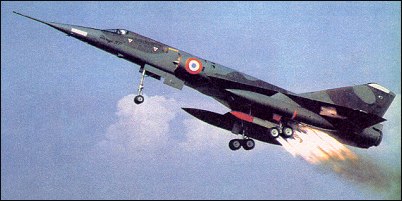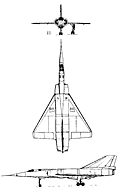 |
Dassault Mirage IV1959 |  |
| STRATEGIC BOMBER | Virtual Aircraft Museum / France / Dassault |
 |
Renowned for highly nationalistic policies, the French decided in 1954 to create their own nuclear deterrent force. One of the first priorities was to develop a launch platform for the weapons, a project headed by Dassault in association with a number of other companies. With a requirement for a long-range high-speed mission to be met, Dassault looked initially at developments of the Vautour but later directed its attention to a twin-engined night-fighter design of 1956. Basically a scaled-up Mirage III, the project redesign considered many changes in size and powerplant as speed, load and range requirements were formulated, but the solution became clearer when it was decided to make extensive use of inflight-refuelling. The first Dassault Mirage IVA prototype flew on 17 June 1959, then powered by two 6000kg SNECMA Atar 09 augmented turbojets. On its 14th test flight during July 1959 it reached Mach 1.9, and attained Mach 2 on its 33rd flight. Three pre-production prototypes followed, the first of which flew on 12 October 1961. Powered by a pair of 6400kg Atar 9Cs, this aircraft was larger and more representative of the production Mirage IVA, incorporating a large circular radome under the centre fuselage forward of the semi-recessed nuclear free-fall bomb. The first of these pre-production aircraft was used for bombing trials and development at Colomb-Bechar; the second similar aircraft was used to develop the navigation and inflight-refuelling systems; and the third, a completely operational model with Atar 9Ks, full equipment including nose-probe for refuelling and armament, flew on 23 January 1963. Satisfied with the trials, the French air force ordered 50 production aircraft for delivery in 1964-5, with a repeat order for a further 12 placed later. Although a heavy aircraft and fairly 'hot' to operate, the Mirage IVs of the French air force are maintained on an extremely quick alert. They can take-off directly from the hardened shelters in which they are housed with their engines running at full power, and have even been used from short unpaved strips with the aid of auxiliary take-off rockets, operating from surfaces which have been hardened by the application of fast-drying chemicals. The last of nine Mirage IVA strategic bomber units disbanded in July 1988 with passing of the French nuclear deterrent to silo-based S-3 strategic missiles. However, two units still operate remaining Mirage IVPs {= Penetration) of 18 upgraded between May 1983 and December 1987 to carry the ASMP medium-range nuclear-tipped air-to-surface missile. Mirage IVPs have Arcana pulse doppler radar, dual inertial navigation systems, a Thomson-CSF Barem self protection jamming pod, a BOZ-100 chaff/flare pod and Thomson-CSF Serval radar warning receivers. Eighteen unconverted Mirage IVAs remain in store.

|  COMPANY PROFILE | |||||||||||||||||||||||||||||||||||||||||||||||||||||||||||||||
 |

|

